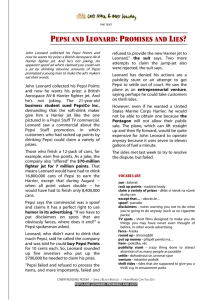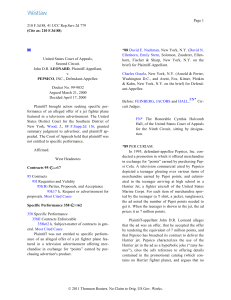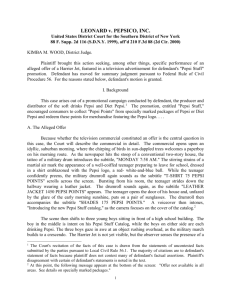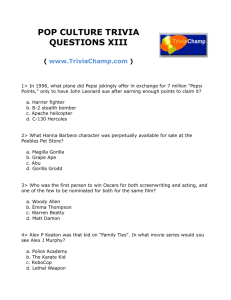LEONARD v. PEPSICO United States District Court, S.D. New York
advertisement
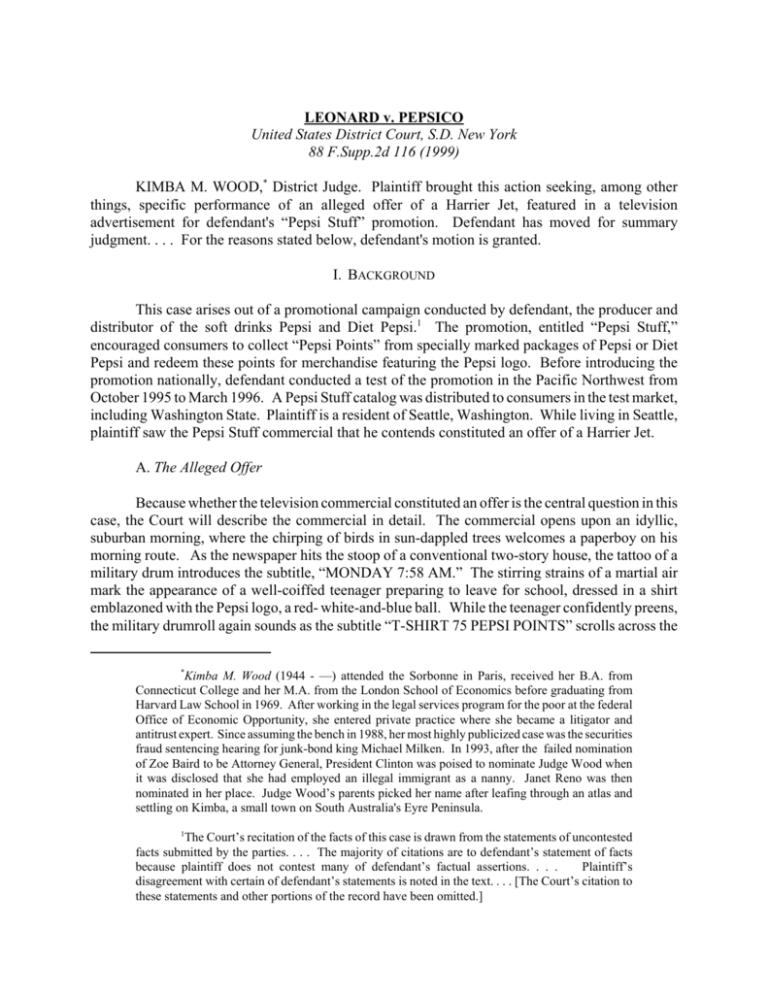
LEONARD v. PEPSICO United States District Court, S.D. New York 88 F.Supp.2d 116 (1999) KIMBA M. WOOD,* District Judge. Plaintiff brought this action seeking, among other things, specific performance of an alleged offer of a Harrier Jet, featured in a television advertisement for defendant's “Pepsi Stuff” promotion. Defendant has moved for summary judgment. . . . For the reasons stated below, defendant's motion is granted. I. BACKGROUND This case arises out of a promotional campaign conducted by defendant, the producer and distributor of the soft drinks Pepsi and Diet Pepsi.1 The promotion, entitled “Pepsi Stuff,” encouraged consumers to collect “Pepsi Points” from specially marked packages of Pepsi or Diet Pepsi and redeem these points for merchandise featuring the Pepsi logo. Before introducing the promotion nationally, defendant conducted a test of the promotion in the Pacific Northwest from October 1995 to March 1996. A Pepsi Stuff catalog was distributed to consumers in the test market, including Washington State. Plaintiff is a resident of Seattle, Washington. While living in Seattle, plaintiff saw the Pepsi Stuff commercial that he contends constituted an offer of a Harrier Jet. A. The Alleged Offer Because whether the television commercial constituted an offer is the central question in this case, the Court will describe the commercial in detail. The commercial opens upon an idyllic, suburban morning, where the chirping of birds in sun-dappled trees welcomes a paperboy on his morning route. As the newspaper hits the stoop of a conventional two-story house, the tattoo of a military drum introduces the subtitle, “MONDAY 7:58 AM.” The stirring strains of a martial air mark the appearance of a well-coiffed teenager preparing to leave for school, dressed in a shirt emblazoned with the Pepsi logo, a red- white-and-blue ball. While the teenager confidently preens, the military drumroll again sounds as the subtitle “T-SHIRT 75 PEPSI POINTS” scrolls across the * Kimba M. Wood (1944 - —) attended the Sorbonne in Paris, received her B.A. from Connecticut College and her M.A. from the London School of Economics before graduating from Harvard Law School in 1969. After working in the legal services program for the poor at the federal Office of Economic Opportunity, she entered private practice where she became a litigator and antitrust expert. Since assuming the bench in 1988, her most highly publicized case was the securities fraud sentencing hearing for junk-bond king Michael Milken. In 1993, after the failed nomination of Zoe Baird to be Attorney General, President Clinton was poised to nominate Judge Wood when it was disclosed that she had employed an illegal immigrant as a nanny. Janet Reno was then nominated in her place. Judge Wood’s parents picked her name after leafing through an atlas and settling on Kimba, a small town on South Australia's Eyre Peninsula. 1 The Court’s recitation of the facts of this case is drawn from the statements of uncontested facts submitted by the parties. . . . The majority of citations are to defendant’s statement of facts because plaintiff does not contest many of defendant’s factual assertions. . . . Plaintiff’s disagreement with certain of defendant’s statements is noted in the text. . . . [The Court’s citation to these statements and other portions of the record have been omitted.] screen. Bursting from his room, the teenager strides down the hallway wearing a leather jacket. The drumroll sounds again, as the subtitle “LEATHER JACKET 1450 PEPSI POINTS” appears. The teenager opens the door of his house and, unfazed by the glare of the early morning sunshine, puts on a pair of sunglasses. The drumroll then accompanies the subtitle “SHADES 175 PEPSI POINTS.” A voiceover then intones, “Introducing the new Pepsi Stuff catalog,” as the camera focuses on the cover of the catalog.2 The scene then shifts to three young boys sitting in front of a high school building. The boy in the middle is intent on his Pepsi Stuff Catalog, while the boys on either side are each drinking Pepsi. The three boys gaze in awe at an object rushing overhead, as the military march builds to a crescendo. The Harrier Jet is not yet visible, but the observer senses the presence of a mighty plane as the extreme winds generated by its flight create a paper maelstrom in a classroom devoted to an otherwise dull physics lesson. Finally, the Harrier Jet swings into view and lands by the side of the school building, next to a bicycle rack. Several students run for cover, and the velocity of the wind strips one hapless faculty member down to his underwear. While the faculty member is being deprived of his dignity, the voiceover announces: “Now the more Pepsi you drink, the more great stuff you’re gonna get.” The teenager opens the cockpit of the fighter and can be seen, helmetless, holding a Pepsi. “[L]ooking very pleased with himself,” the teenager exclaims, “Sure beats the bus,” and chortles. The military drumroll sounds a final time, as the following words appear: “HARRIER FIGHTER 7,000,000 PEPSI POINTS.” A few seconds later, the following appears in more stylized script: “Drink Pepsi—Get Stuff.” With that message, the music and the commercial end with a triumphant flourish. Inspired by this commercial, plaintiff set out to obtain a Harrier Jet. Plaintiff explains that he is “typical of the ‘Pepsi Generation’ . . . he is young, has an adventurous spirit, and the notion of obtaining a Harrier Jet appealed to him enormously.” Plaintiff consulted the Pepsi Stuff Catalog. The Catalog features youths dressed in Pepsi Stuff regalia or enjoying Pepsi Stuff accessories, such as “Blue Shades” (“As if you need another reason to look forward to sunny days.”), “Pepsi Tees” (“Live in ’em. Laugh in ’em. Get in ’em.”), “Bag of Balls” (“Three balls. One bag. No rules.”), and “Pepsi Phone Card” (“Call your mom!”). The Catalog specifies the number of Pepsi Points required to obtain promotional merchandise. The Catalog includes an Order Form which lists, on one side, fifty-three items of Pepsi Stuff merchandise redeemable for Pepsi Points. Conspicuously absent from the Order Form is any entry or description of a Harrier Jet. The amount of Pepsi Points required to obtain the listed merchandise ranges from 15 (for a “Jacket Tattoo” (“Sew ’em on your jacket, not your arm.”)) to 3300 (for a “Fila Mountain Bike” (“Rugged. All-terrain. Exclusively for Pepsi.”)). It should be noted that plaintiff objects to the implication that because an item was not shown in the Catalog, it was unavailable. The rear foldout pages of the Catalog contain directions for redeeming Pepsi Points for merchandise. These directions note that merchandise may be ordered “only” with the original Order Form. The Catalog notes that in the event that a consumer lacks enough Pepsi Points to obtain a desired item, additional Pepsi Points may be purchased for ten cents each; however, at least fifteen original Pepsi Points must accompany each order. Although plaintiff initially set out to collect 7,000,000 Pepsi Points by consuming Pepsi 2 At this point, the following message appears at the bottom of the screen:“Offer not available in all areas. See details on specially marked packages.” products, it soon became clear to him that he “would not be able to buy (let alone drink) enough Pepsi to collect the necessary Pepsi Points fast enough.” Reevaluating his strategy, plaintiff “focused for the first time on the packaging materials in the Pepsi Stuff promotion,” and realized that buying Pepsi Points would be a more promising option. Through acquaintances, plaintiff ultimately raised about $700,000. B. Plaintiff’s Efforts to Redeem the Alleged Offer On or about March 27, 1996, plaintiff submitted an Order Form, fifteen original Pepsi Points, and a check for $700,008.50. Plaintiff appears to have been represented by counsel at the time he mailed his check; the check is drawn on an account of plaintiff’s first set of attorneys. At the bottom of the Order Form, plaintiff wrote in “1 Harrier Jet” in the “Item” column and “7,000,000” in the “Total Points” column. In a letter accompanying his submission, plaintiff stated that the check was to purchase additional Pepsi Points “expressly for obtaining a new Harrier jet as advertised in your Pepsi Stuff commercial.” On or about May 7, 1996, defendant’s fulfillment house rejected plaintiff’s submission and returned the check, explaining that: The item that you have requested is not part of the Pepsi Stuff collection. It is not included in the catalogue or on the order form, and only catalogue merchandise can be redeemed under this program. The Harrier jet in the Pepsi commercial is fanciful and is simply included to create a humorous and entertaining ad. We apologize for any misunderstanding or confusion that you may have experienced and are enclosing some free product coupons for your use. Plaintiff’s previous counsel responded on or about May 14, 1996, as follows: Your letter of May 7, 1996 is totally unacceptable. We have reviewed the video tape of the Pepsi Stuff commercial . . . and it clearly offers the new Harrier jet for 7,000,000 Pepsi Points. Our client followed your rules explicitly. . . . This is a formal demand that you honor your commitment and make immediate arrangements to transfer the new Harrier jet to our client. If we do not receive transfer instructions within ten (10) business days of the date of this letter you will leave us no choice but to file an appropriate action against Pepsi. . . . This letter was apparently sent onward to the advertising company responsible for the actual commercial, BBDO New York. In a letter dated May 30, 1996, BBDO Vice President Raymond E. McGovern, Jr., explained to plaintiff that: I find it hard to believe that you are of the opinion that the Pepsi Stuff commercial (“Commercial”) really offers a new Harrier Jet. The use of the Jet was clearly a joke that was meant to make the Commercial more humorous and entertaining. In my opinion, no reasonable person would agree with your analysis of the Commercial. On or about June 17, 1996, plaintiff mailed a similar demand letter to defendant. . . . PepsiCo brought suit in this Court on July 18, 1996, seeking a declaratory judgment stating that it had no obligation to furnish plaintiff with a Harrier Jet. . . . II. DISCUSSION . . . As plaintiff suggests, the questions presented by this case implicate questions of contract law “deeply ingrained in the common law of England and the States of the Union.” B. Defendant’s Advertisement Was Not An Offer 1. Advertisements as Offers The general rule is that an advertisement does not constitute an offer. The Restatement (Second) of Contracts explains that: Advertisements of goods by display, sign, handbill, newspaper, radio or television are not ordinarily intended or understood as offers to sell. The same is true of catalogues, price lists and circulars, even though the terms of suggested bargains may be stated in some detail. It is of course possible to make an offer by an advertisement directed to the general public (see § 29), but there must ordinarily be some language of commitment or some invitation to take action without further communication. Restatement (Second) of Contracts § 26 cmt. b (1979). Similarly, a leading treatise notes that: It is quite possible to make a definite and operative offer to buy or sell goods by advertisement, in a newspaper, by a handbill, a catalog or circular or on a placard in a store window. It is not customary to do this, however; and the presumption is the other way. . . . Such advertisements are understood to be mere requests to consider and examine and negotiate; and no one can reasonably regard them as otherwise unless the circumstances are exceptional and the words used are very plain and clear. 1 Arthur Linton Corbin & Joseph M. Perillo, Corbin on Contracts § 2.4, at 116-17 (rev. ed.1993) (emphasis added); see also 1 E. Allan Farnsworth, Farnsworth on Contracts § 3.10, at 239 (2d ed.1998); 1 Samuel Williston & Richard A. Lord, A Treatise on the Law of Contracts § 4:7, at 286-87 (4th ed.1990). New York courts adhere to this general principle. See Lovett v. Frederick Loeser & Co., 207 N.Y.S. 753, 755 (N.Y.Mun.Ct.1924) (noting that an “advertisement is nothing but an invitation to enter into negotiations, and is not an offer which may be turned into a contract by a person who signifies his intention to purchase some of the articles mentioned in the advertisement”). . . . An advertisement is not transformed into an enforceable offer merely by a potential offeree’s expression of willingness to accept the offer through, among other means, completion of an order form. In Mesaros v. United States, 845 F.2d 1576 (Fed.Cir.1988), for example, the plaintiffs sued the United States Mint for failure to deliver a number of Statue of Liberty commemorative coins that they had ordered. When demand for the coins proved unexpectedly robust, a number of individuals who had sent in their orders in a timely fashion were left empty-handed. The court began by noting the ‘well-established’ rule that advertisements and order forms are “mere notices and solicitations for offers which create no power of acceptance in the recipient.” Id. at 1580; see also . . . Restatement (Second) of Contracts § 26 (“A manifestation of willingness to enter a bargain is not an offer if the person to whom it is addressed knows or has reason to know that the person making it does not intend to conclude a bargain until he has made a further manifestation of assent.”). The spurned coin collectors could not maintain a breach of contract action because no contract would be formed until the advertiser accepted the order form and processed payment. . . Under these principles, plaintiff’s letter of March 27, 1996, with the Order Form and the appropriate number of Pepsi Points, constituted the offer. There would be no enforceable contract until defendant accepted the Order Form and cashed the check. The exception to the rule that advertisements do not create any power of acceptance in potential offerees is where the advertisement is “clear, definite, and explicit, and leaves nothing open for negotiation,” in that circumstance, “it constitutes an offer, acceptance of which will complete the contract.” Lefkowitz v. Great Minneapolis Surplus Store, 251 Minn. 188, 86 N.W.2d 689, 691 (1957). In Lefkowitz, defendant had published a newspaper announcement stating: “Saturday 9 AM Sharp, 3 Brand New Fur Coats, Worth to $100.00, First Come FirstServed $1 Each.” Mr. Morris Lefkowitz arrived at the store, dollar in hand, but was informed that under defendant's “house rules,” the offer was open to ladies, but not gentlemen. The court ruled that because plaintiff had fulfilled all of the terms of the advertisement and the advertisement was specific and left nothing open for negotiation, a contract had been formed. . . The present case is distinguishable from Lefkowitz. First, the commercial cannot be regarded in itself as sufficiently definite, because it specifically reserved the details of the offer to a separate writing, the Catalog.3 The commercial itself made no mention of the steps a potential offeree would be required to take to accept the alleged offer of a Harrier Jet. The advertisement in Lefkowitz, in contrast, “identified the person who could accept.” Corbin, supra, § 2.4, at 119. See generally United States v. Braunstein, 75 F.Supp. 137, 139 (S.D.N.Y.1947) (“Greater precision of expression may be required, and less help from the court given, when the parties are merely at the threshold of a contract.”); Farnsworth, supra, at 239 (“The fact that a proposal is very detailed suggests that it is an offer, while omission of many terms suggests that it is not.”).4 Second, even if the Catalog had included a Harrier Jet among the items that could be obtained by redemption of Pepsi Points, the advertisement of a Harrier Jet by both television commercial and catalog would still not constitute an offer. As the Mesaros court explained, the absence of any words of limitation such as “first come, first served,” renders the alleged offer sufficiently indefinite that no contract could be formed. See Mesaros, 845 F.2d at 1581. “A customer would not usually have reason to believe that the shopkeeper intended exposure to the risk of a multitude of acceptances resulting in a number of contracts exceeding the shopkeeper's inventory.” Farnsworth, supra, at 242. There was no such danger in Lefkowitz, owing to the limitation “first come, first served.” The Court finds, in sum, that the Harrier Jet commercial was merely an advertisement. . . . C. An Objective, Reasonable Person Would Not Have Considered the Commercial an Offer Plaintiff’s understanding of the commercial as an offer must also be rejected because the Court finds that no objective person could reasonably have concluded that the commercial actually offered consumers a Harrier Jet. 3 It also communicated additional words of reservation:“Offer not available in all areas. See details on specially marked packages.” 4 The reservation of the details of the offer in this case distinguishes it from Payne v. Lautz Bros. & Co., 166 N.Y.S. 844 (N.Y.City Ct.1916). In Payne, a stamp and coupon broker purchased massive quantities of coupons produced by defendant, a soap company, and tried to redeem them for 4,000 round-trip tickets to a local beach. The court ruled for plaintiff, noting that the advertisements were ”absolutely unrestricted. It contained no reference whatever to any of its previous advertising of any form.” Id. at 848. In the present case, by contrast, the commercial explicitly reserved the details of the offer to the Catalog. 1. Objective Reasonable Person Standard In evaluating the commercial, the Court must not consider defendant’s subjective intent in making the commercial, or plaintiff’s subjective view of what the commercial offered, but what an objective, reasonable person would have understood the commercial to convey. See Kay-R Elec. Corp. v. Stone & Webster Constr. Co., 23 F.3d 55, 57 (2d Cir.1994) (“[W]e are not concerned with what was going through the heads of the parties at the time [of the alleged contract]. Rather, we are talking about the objective principles of contract law.”); Mesaros, 845 F.2d at 1581 (“A basic rule of contracts holds that whether an offer has been made depends on the objective reasonableness of the alleged offeree’s belief that the advertisement or solicitation was intended as an offer.”). . . . If it is clear that an offer was not serious, then no offer has been made: What kind of act creates a power of acceptance and is therefore an offer? It must be an expression of will or intention. It must be an act that leads the offeree reasonably to conclude that a power to create a contract is conferred. This applies to the content of the power as well as to the fact of its existence. It is on this ground that we must exclude invitations to deal or acts of mere preliminary negotiation, and acts evidently done in jest or without intent to create legal relations. Corbin on Contracts, § 1.11 at 30 (emphasis added). An obvious joke, of course, would not give rise to a contract. See, e.g., Graves v. Northern N.Y. Pub. Co., 260 A.D. 900, 22 N.Y.S.2d 537 (1940) (dismissing claim to offer of $1000, which appeared in the “joke column” of the newspaper, to any person who could provide a commonly available phone number). On the other hand, if there is no indication that the offer is “evidently in jest,” and that an objective, reasonable person would find that the offer was serious, then there may be a valid offer. See Barnes, 549 P.2d at 1155 (“[I]f the jest is not apparent and a reasonable hearer would believe that an offer was being made, then the speaker risks the formation of a contract which was not intended.”); see also Lucy v. Zehmer, 196 Va. 493, 84 S.E.2d 516, 518, 520 (1954) (ordering specific performance of a contract to purchase a farm despite defendant's protestation that the transaction was done in jest as “‘just a bunch of two doggoned drunks bluffing’”). . . . 3. Whether the Commercial Was "Evidently Done In Jest" Plaintiff’s insistence that the commercial appears to be a serious offer requires the Court to explain why the commercial is funny. Explaining why a joke is funny is a daunting task; as the essayist E.B. White has remarked, “Humor can be dissected, as a frog can, but the thing dies in the process. . . .” The commercial is the embodiment of what defendant appropriately characterizes as “zany humor.” First, the commercial suggests, as commercials often do, that use of the advertised product will transform what, for most youth, can be a fairly routine and ordinary experience. The military tattoo and stirring martial music, as well as the use of subtitles in a Courier font that scroll terse messages across the screen, such as “MONDAY 7:58 AM,” evoke military and espionage thrillers. The implication of the commercial is that Pepsi Stuff merchandise will inject drama and moment into hitherto unexceptional lives. The commercial in this case thus makes the exaggerated claims similar to those of many television advertisements: that by consuming the featured clothing, car, beer, or potato chips, one will become attractive, stylish, desirable, and admired by all. A reasonable viewer would understand such advertisements as mere puffery, not as statements of fact, see, e.g., Hubbard v. General Motors Corp., 1996 WL 274018, at *6 (S.D.N.Y. May 22, 1996) (advertisement describing automobile as “Like a Rock,” was mere puffery, not a warranty of quality). . . . and refrain from interpreting the promises of the commercial as being literally true. Second, the callow youth featured in the commercial is a highly improbable pilot, one who could barely be trusted with the keys to his parents’ car, much less the prize aircraft of the United States Marine Corps. Rather than checking the fuel gauges on his aircraft, the teenager spends his precious preflight minutes preening. The youth’s concern for his coiffure appears to extend to his flying without a helmet. Finally, the teenager’s comment that flying a Harrier Jet to school “sure beats the bus” evinces an improbably insouciant attitude toward the relative difficulty and danger of piloting a fighter plane in a residential area, as opposed to taking public transportation. Third, the notion of traveling to school in a Harrier Jet is an exaggerated adolescent fantasy. In this commercial, the fantasy is underscored by how the teenager’s schoolmates gape in admiration, ignoring their physics lesson. The force of the wind generated by the Harrier Jet blows off one teacher's clothes, literally defrocking an authority figure. As if to emphasize the fantastic quality of having a Harrier Jet arrive at school, the Jet lands next to a plebeian bike rack. This fantasy is, of course, extremely unrealistic. No school would provide landing space for a student’s fighter jet, or condone the disruption the jet's use would cause. Fourth, the primary mission of a Harrier Jet, according to the United States Marine Corps, is to “attack and destroy surface targets under day and night visual conditions. . . . Manufactured by McDonnell Douglas, the Harrier Jet played a significant role in the air offensive of Operation Desert Storm in 1991. . . . The jet is designed to carry a considerable armament load, including Sidewinder and Maverick missiles. As one news report has noted, “Fully loaded, the Harrier can float like a butterfly and sting like a bee—albeit a roaring 14-ton butterfly and a bee with 9,200 pounds of bombs and missiles.” Jerry Allegood, Marines Rely on Harrier Jet, Despite Critics, News & Observer (Raleigh), Nov. 4, 1990, at C1. In light of the Harrier Jet’s well-documented function in attacking and destroying surface and air targets, armed reconnaissance and air interdiction, and offensive and defensive anti-aircraft warfare, depiction of such a jet as a way to get to school in the morning is clearly not serious even if, as plaintiff contends, the jet is capable of being acquired “in a form that eliminates [its] potential for military use.” Fifth, the number of Pepsi Points the commercial mentions as required to “purchase” the jet is 7,000,000. To amass that number of points, one would have to drink 7,000,000 Pepsis (or roughly 190 Pepsis a day for the next hundred years—an unlikely possibility), or one would have to purchase approximately $700,000 worth of Pepsi Points. The cost of a Harrier Jet is roughly $23 million dollars, a fact of which plaintiff was aware when he set out to gather the amount he believed necessary to accept the alleged offer. Even if an objective, reasonable person were not aware of this fact, he would conclude that purchasing a fighter plane for $700,000 is a deal too good to be true. Plaintiff argues that a reasonable, objective person would have understood the commercial to make a serious offer of a Harrier Jet because there was “absolutely no distinction in the manner” in which the items in the commercial were presented. Plaintiff also relies upon a press release highlighting the promotional campaign, issued by defendant, in which “[n]o mention is made by [defendant] of humor, or anything of the sort.” These arguments suggest merely that the humor of the promotional campaign was tongue in cheek. Humor is not limited to what Justice Cardozo called “[t]he rough and boisterous joke . . . [that] evokes its own guffaws.” Murphy v. Steeplechase Amusement Co., 250 N.Y. 479, 483, 166 N.E. 173, 174 (1929). In light of the obvious absurdity of the commercial, the Court rejects plaintiff’s argument that the commercial was not clearly in jest. ... For the reasons stated above, the Court grants defendant’s motion for summary judgment.

